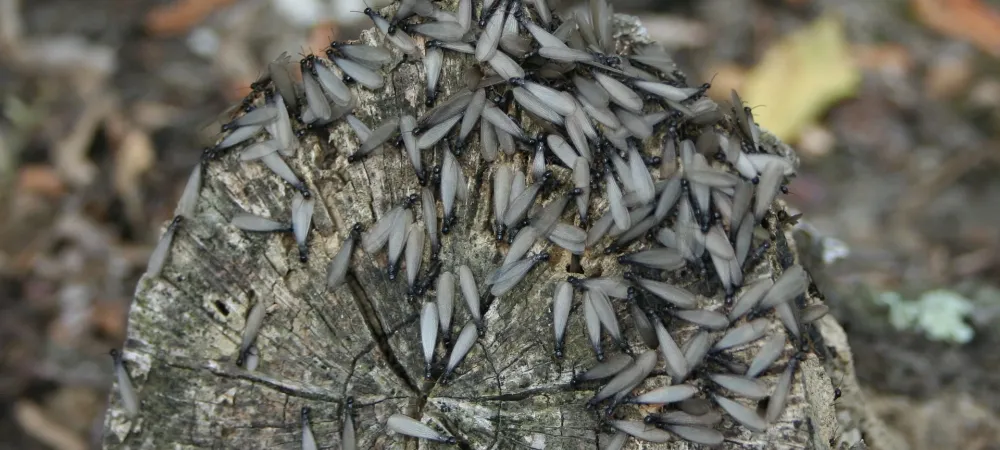Termites vs Ants

Termites and ants have many behaviors in common. Most importantly, they can both cause significant structural damage to the wood frame of your home. However, termites and flying ants also have many differences. Understanding the similarities and differences between their appearance, nesting habits, diet, droppings, and lifespan is critically important so that you have your infestation properly treated.
Appearance of Termites vs Ants
There is a noticeable physical difference in the appearance of termites vs ants. These differences will help you to tell them apart and recognize the pest that is in or near your home. Termites and flying ants differ in body shape, color, antennae, and wing size.
Body Shape
One main difference between termites and flying ants is the shape of their bodies. While both have three segments, carpenter ants, and most flying ants, have narrow waists while termites have broad waists.
Color
Termites and ants vary vastly in their coloring. Flying ants are often reddish or dark in color. Termite workers are transparent, light, or creamy white in color.
Antennae
Termites have straight beaded antennae while flying ants' antennae are bent or elbowed.
Wings
Termites and ants, specifically flying ants, both have four wings. A termite has wings that are of equal size and shape and they are much larger than their body appearing to be disproportionate. A flying ant’s back wings are shorter than its front wings and the wings do not look to be in proportion with the ant’s body. Another difference is that termite wings fall off easily. The loose wings can often be found near the opening of a termite nest and can provide another clue as to the type of infestation.
Nesting Habits of Termites vs Ants
Termites and ants have very different nesting habits. Carpenter ants dig into moist or damaged wood to create their nest. They work to excavate the wood to create their nest. They push the wood out in this process as they build their colony. If small piles of shavings are found, carpenter ants will likely be at work. Termites, like the subterranean termite, build their nests underground. They often create mud tubes outside of their nest through which they travel. These mud tubes can be found on the outside of walls or between the soil and the wood that is being consumed.
Diet of Termites vs Ants
Ants forage in the open while termites remain hidden unless their nest is disturbed. Termites are known for eating wooden structures as they consume the cellulose in the wood to survive. In contrast, flying ants, including carpenter ants, do not eat wood. Rather, ants consume sugars and proteins and eat other insects. These differences explain what attracts termites and ants to your house. Their diets lead them both to seek food sources outside of their nest and moist environments in and around your home.
Droppings of Termites vs Ants
Ants have thicker and less processed droppings, which can contain pieces of wood particles, feces, dirt, and sometimes, parts of dead ants. Termites have much finer droppings, which often resemble grains of salt and pepper. Both droppings contain wood, however, because ant droppings contain other elements from their diet their droppings are more dangerous.
The Lifespan of Termites vs Ants
The lifespan of termites vs ants is quite different with termites living much longer with an expanded life cycle. A queen carpenter ant can live as long as 10 years, yet male ants only live for a few weeks to a few months. Termite queens can live for a very long time, over 30 years! Worker and soldier termites can live an average of one to two years and reproductive termites, also known as swarmers, live three to four years.
Professional Termite Control Services
If you're noticing signs of either termites or carpenter ants, call Greenleaf for termite control in Phoenix and the surrounding area. Wood-destroying insects should not be taken lightly, so contact Greenleaf today for an inspection and treatment if needed.
FAQs About Ants and Termites
Below you will find frequently asked questions about ants and termites with answers that will help you to differentiate between the two.
Are Ants Stronger Than Termites?
Ants are much smaller in size than termites, however, they are stronger and can annihilate an entire termite colony. The main reason is their sheer numbers and the fact that they prey on termites as food. Ants can be very aggressive and can take over a termite colony. When ants invade a termite’s nest, they kill the warrior termites and queen right away.
Can Termites be Mistaken for Ants?
Yes, termites can be mistaken for ants, especially when they are flying in a swarm. It can be difficult to spot the differences even when you are aware of them and looking carefully.
Can You Have Termites and Ants at the Same Time?
Yes, both of them can exist in the same home. You will likely see ants crawling about before you see the appearance of any termites as they prefer to hide underground.
Carpenter Ants vs Termites
Carpenter ants are very different in appearance, nesting, and diet than termites. It is important to note the differences so that you can determine what kind of pest is invading your property or home. One big difference is that carpenter ants do not eat wood and termites do, however, they both can cause extensive damage to wooden structures in or near your home.
Which Is Worse: Termites or Ants?
Most ants are less damaging to human habitats than termites. Termites create far more destruction in a much shorter amount of time.





